For Kevin Hendricks, the tug of theater isn’t what you might suspect
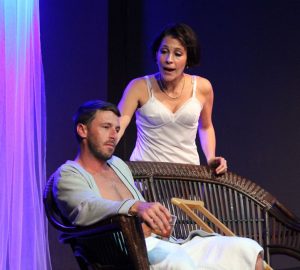 In his last role for The Studio Players, Kevin Hendricks played Brick Pollitt in Tennessee Williams’ Cat on a Hot Tin Roof. His character was in a leg cast and on crutches after failing to negotiate a hurdle at the football stadium where he’d attained glory during his high school years. Compliments of a side-by-side ATV accident (alcohol may or may not have also been involved), Hendricks finds himself in a cast, on crutches and quarantined following patella tendon surgery. So he clearly has
In his last role for The Studio Players, Kevin Hendricks played Brick Pollitt in Tennessee Williams’ Cat on a Hot Tin Roof. His character was in a leg cast and on crutches after failing to negotiate a hurdle at the football stadium where he’d attained glory during his high school years. Compliments of a side-by-side ATV accident (alcohol may or may not have also been involved), Hendricks finds himself in a cast, on crutches and quarantined following patella tendon surgery. So he clearly has 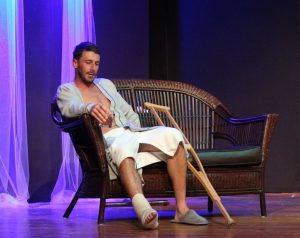 time to take stock of his theatrical career and acting aspirations.
time to take stock of his theatrical career and acting aspirations.
Hendricks didn’t come to acting in anywhere close to the conventional way. (That’s another story.) So his goals and expectations are not what you’d normally expect.
Oh, sure, he delights in the attention. In school, he played the class clown.
“I went to school 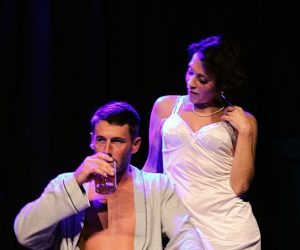 to make people laugh, and I loved that,” Kevin confesses. “But the farther I got away from school, the less I got to entertain people.”
to make people laugh, and I loved that,” Kevin confesses. “But the farther I got away from school, the less I got to entertain people.”
But he draws his greatest satisfaction from making people feel something, particularly something they didn’t expect when they came to see him perform.
“You can feel it on stage – the silence when people are really paying attention, when they’re leaning a little closer. When you hear people gasp. And then there’s the applause afterwards, 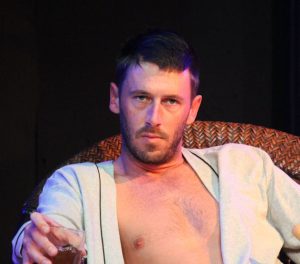 when it’s genuine. Or when they stand for an ovation, and you can see the smiles on their faces.”
when it’s genuine. Or when they stand for an ovation, and you can see the smiles on their faces.”
However, for Hendricks, it’s the commentary afterwards that says the most about what the audience really thought about what he did on stage. Hendricks typically plays hard cases. In addition to Brick Pollitt, he’s played Stanley Kowalski in Streetcar and Pale in Burn This. All three characters are menacing, profane, and dangerous-bordering- on-terrifying.
on-terrifying.
“If I’ve done my job, they’ll be a little wary or intimidated when they come shake your hand. That’s when you know you were believable up there. You’re just you in your eyes, but strangers don’t know you even if they’ve seen you in other shows. So if you’ve done a good enough job, you’re a drunk or you’re scary [in their eyes].”
It’s a moment from which Hendricks draws considerable 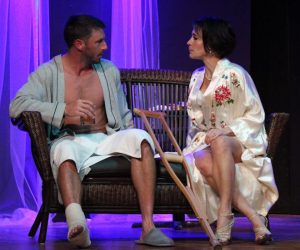 pride.
pride.
“They spent good money and their night to watch you and your fellow actors perform. You don’t get that at a regular job, where people came for something other than to see you. So that’s pretty cool.”
But don’t glean from these comments that it’s all about him. Hendricks draws even more satisfaction and validation from the group dynamic in 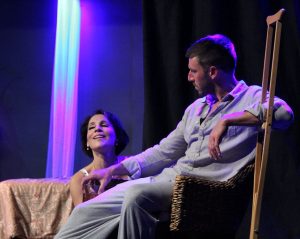 operation in a well-oiled, tightly-run theater production like Cat on a Hot Tin Roof, in which all six cast members turned in amazingly strong performances.
operation in a well-oiled, tightly-run theater production like Cat on a Hot Tin Roof, in which all six cast members turned in amazingly strong performances.
“I grew up playing team sports, mostly basketball. I was captain of the varsity team, not because I was the best player, but because I was a leader, because I cared about the overall team. When I got into theater, the same feelings came back because as a cast, we’re only as good as our weakest performer. 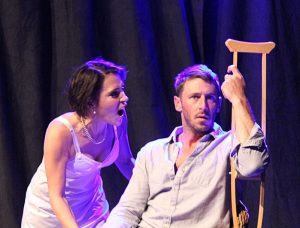 It doesn’t matter how good I am or Rachel [Borwein] or Vic [Caroli] is. If we have someone up there who’s not performing at [the same] level, they detract from the fantasy and remind people [that what they’re watching] isn’t real.”
It doesn’t matter how good I am or Rachel [Borwein] or Vic [Caroli] is. If we have someone up there who’s not performing at [the same] level, they detract from the fantasy and remind people [that what they’re watching] isn’t real.”
In contrast to team sports, neither critics nor audience members keep stats on individual actors (although critics do criticize or 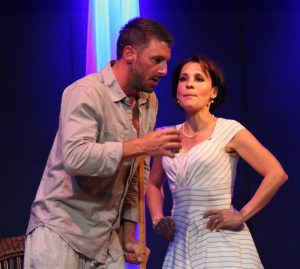 praise individual performances). By a production’s very nature, actors, directors and crew are generally judged on the quality of the overall performance. So when everyone’s on the same page and performing in rhythm at their absolute peak, the cast and crew typically experience the same type of high that championship basketball, football and other teams talk about following a game for the ages.
praise individual performances). By a production’s very nature, actors, directors and crew are generally judged on the quality of the overall performance. So when everyone’s on the same page and performing in rhythm at their absolute peak, the cast and crew typically experience the same type of high that championship basketball, football and other teams talk about following a game for the ages.
“You can’t do it by yourself. It’s such an euphoric feeling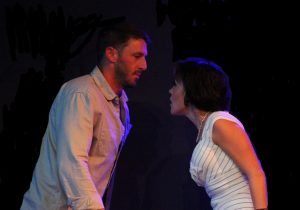 when everyone is on point together and you nail a scene. And it’s just as cool if someone goes up [forgets or misses] on a line or changes the blocking because of what our character is feeling that night, and everyone else picks it up because we’ve been grooving for such a long time. Someone will have your back, and you’ll have their back, and that creates a fearless attitude and effortless
when everyone is on point together and you nail a scene. And it’s just as cool if someone goes up [forgets or misses] on a line or changes the blocking because of what our character is feeling that night, and everyone else picks it up because we’ve been grooving for such a long time. Someone will have your back, and you’ll have their back, and that creates a fearless attitude and effortless 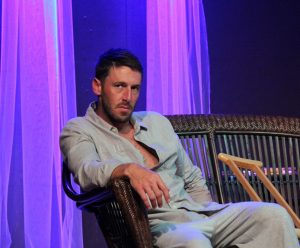 performance.”
performance.”
In Cat on a Hot Tin Roof, Hendricks’ character was a man of few words. In fact, he spent large amounts of time sitting, brooding and draining one drink after another. But when he finally did speak, he always seemed to have just the right words. You have no idea how satisfying Kevin Hendricks finds that!
“Acting provides the perfect reaction to things that happen 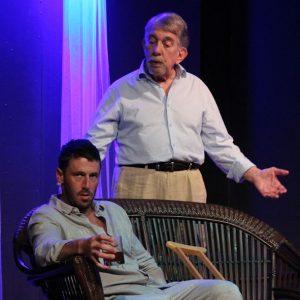 to you in real life,” Kevin explains with his leg propped up on a footstool a’ la Brick Pollitt. “It’s perfect because someone had the time to think it through and write it down on paper in a beautiful script.”
to you in real life,” Kevin explains with his leg propped up on a footstool a’ la Brick Pollitt. “It’s perfect because someone had the time to think it through and write it down on paper in a beautiful script.”
Lines that you’d never have the time or presence of mind to think of in real life, or the temerity to say.
“Real human interaction is boring. You never actually say what you really want to say about how you’re feeling. You say things that bounce around the real truth. Well, in a play or movie, 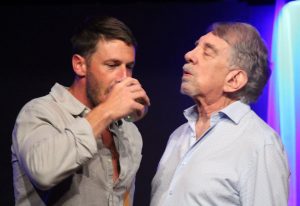 the playwright or screenwriter has written it out. You know how in an argument or an altercation – or even just a conversation with an ex-girlfriend – you always think later of just the right comeback or something else you’d wished you said. Someone who knows how to write says everything perfectly, just the way you would have wanted to say it.”
the playwright or screenwriter has written it out. You know how in an argument or an altercation – or even just a conversation with an ex-girlfriend – you always think later of just the right comeback or something else you’d wished you said. Someone who knows how to write says everything perfectly, just the way you would have wanted to say it.”
And 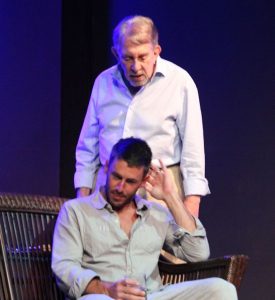 for Hendricks, there’s nothing more satisfying.
for Hendricks, there’s nothing more satisfying.
Of course, Hendricks has been spoiled reciting lines written by playwrights like Tennessee Williams (Streetcar Named Desire, Cat on a Hot Tin Roof) and Lanford Wilson (Burn This).
“There’s something beautiful about being able to make the exact right, poetic, lyrical response that you’d love to make in real life.”
Instead of what you actually say at the spur of the moment because you have all these insecurities blocking you.
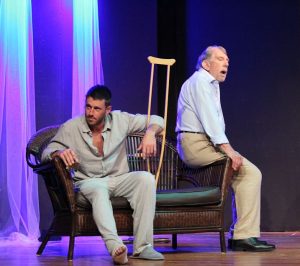 “‘Don’t let them see me get emotional.’ ‘Don’t let them see me cry.’ ‘Don’t say the truth because there’s no coming back from it.’ It pumps you right up. It’s awesome. And you get to deliver those lines exactly the way you’d want to in real life.”
“‘Don’t let them see me get emotional.’ ‘Don’t let them see me cry.’ ‘Don’t say the truth because there’s no coming back from it.’ It pumps you right up. It’s awesome. And you get to deliver those lines exactly the way you’d want to in real life.”
So not only does Hendricks get to entertain people and say just the right thing, he also gets to let his emotions out.
“You always have to be so guarded. When you act, 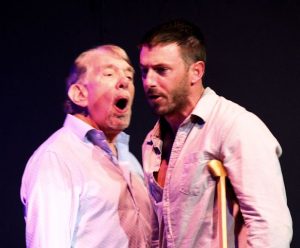 you can let it all out.”
you can let it all out.”
Watching Kevin on stage, it’s easy to forget that he’s a relative newcomer to acting. To date, he’s been in less than a dozen plays. So not only is his upside huge, there’s virtually an unlimited number of roles for him to play. While he assiduously avoids creating a bucket list of roles he’d love to play, there is one role that intrigues him nonetheless.
“I 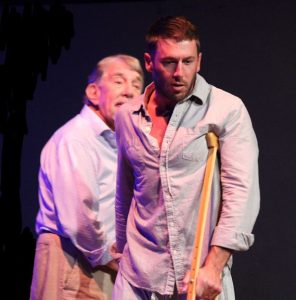 want to play a part that’s never been played before either on stage or in film.”
want to play a part that’s never been played before either on stage or in film.”
Not because he doesn’t want to follow in someone else’s footsteps, but because he wants to set the standard by which subsequent actors are measured.
“Take Streetcar. Everyone’s seen Brando do it. Now they have an idea of who Stanley Kowalksi is because Marlon Brando nailed it. He read that part and he got to define who Stanley Kowalski would be forever after.”
But imagine if someone 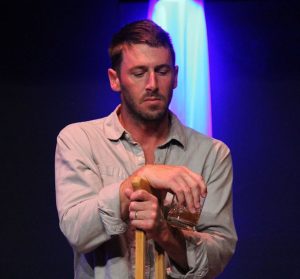 else had been cast in that role and had played it completely different?
else had been cast in that role and had played it completely different?
“I’d like to be in that position, to have that opportunity.”
So playwright and screenwriters take notice. If you have a world premiere or first run movie that you’re developing, Kevin Hendricks is your man.
Just no rom-cons, please.
He prefers the Stanley Kowalskis and Brick Pollitts of stage and  film.
film.
June 9, 2020.
RELATED POSTS.














 Tom Hall is both an amateur artist and aspiring novelist who writes art quest thrillers. He is in the final stages of completing his debut novel titled "Art Detective," a story that fictionalizes the discovery of the fabled billion-dollar Impressionist collection of Parisian art dealer Josse Bernheim-Jeune, thought by many to have perished during World War II when the collection's hiding place, Castle de Rastignac in southern France, was destroyed by the Wehrmacht in reprisal for attacks made by members of the Resistance operating in the area. A former tax attorney, Tom holds a bachelor's degree as well as both a juris doctorate and masters of laws in taxation from the University of Florida. Tom lives in Estero, Florida with his fiancee, Connie, and their four cats.
Tom Hall is both an amateur artist and aspiring novelist who writes art quest thrillers. He is in the final stages of completing his debut novel titled "Art Detective," a story that fictionalizes the discovery of the fabled billion-dollar Impressionist collection of Parisian art dealer Josse Bernheim-Jeune, thought by many to have perished during World War II when the collection's hiding place, Castle de Rastignac in southern France, was destroyed by the Wehrmacht in reprisal for attacks made by members of the Resistance operating in the area. A former tax attorney, Tom holds a bachelor's degree as well as both a juris doctorate and masters of laws in taxation from the University of Florida. Tom lives in Estero, Florida with his fiancee, Connie, and their four cats.